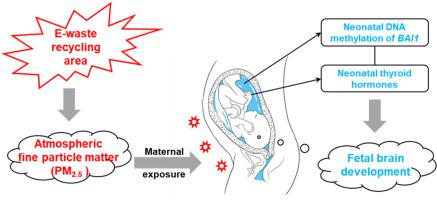Environmental Pollution ( IF 7.6 ) Pub Date : 2022-06-20 , DOI: 10.1016/j.envpol.2022.119665 Zhijun Zeng 1 , Xijin Xu 2 , Qihua Wang 1 , Zhuxia Zhang 1 , Peipei Meng 1 , Xia Huo 1

|
Maternal exposure to atmospheric fine particulate matter (PM2.5) during pregnancy is associated with adverse fetal development, including abnormal brain development. However, the underlying mechanisms and influencing factors remain uncertain. This study investigated the roles of DNA methylation in genes involving neurodevelopment and thyroid hormones (THs) in fetal brain development after maternal exposure to PM2.5 from e-waste. Among 939 healthy pregnant women recruited from June 2011 to September 2012, 101 e-waste-exposed and 103 reference mother-infant pairs (204 pairs totally) were included. Annual ground-level PM2.5 concentrations over e-waste-exposed area (116.38°E, 23.29°N) and reference area (116.67°E, 23.34°N) in 2011, 2012 were obtained by estimates and maternal exposure was evaluated by calculating individual chronic daily intakes (CDIs) of PM2.5. Methylation and THs including thyroid-stimulating hormone (TSH), free triiodothyronine (FT3) and free thyroxine (FT4) level were measured in umbilical cord blood collected shortly after delivery. We found higher ground-level PM2.5 concentrations led to greater individual CDI of PM2.5 in e-waste-exposed pregnant women. After adjustment for gender and birth BMI, significant mediation effects on the adverse associations of maternal PM2.5 exposure with birth head circumference were observed for methylations at positions +13 and + 32 (respectively mediated proportion of 9.8% and 5.3%, P < 0.05 and P < 0.01) in the brain-specific angiogenesis inhibitor 1 (BAI1) gene, but not for methylations in the catenin cadherin-associated protein, alpha 2 (CTNNA2) gene. BAI1 (position +13) methylation was also significantly correlated with FT3 levels (rs = −0.156, P = 0.032), although maternal CDI of PM2.5 was positively associated with higher odds of abnormal TSH levels (OR = 5.03, 95% CI: 1.00, 25.20, P = 0.05) rather than FT3 levels. Our findings suggest that methylation (likely linked to THs) in neonates may play mediation roles associated with abnormal brain development risk due to maternal exposure to atmospheric PM2.5 from e-waste.
中文翻译:

母亲暴露于大气 PM2.5 和胎儿大脑发育:与 BAI1 甲基化和甲状腺激素的关联
孕妇在怀孕期间暴露于大气细颗粒物 (PM 2.5 ) 与胎儿发育不良有关,包括大脑发育异常。然而,潜在的机制和影响因素仍然不确定。本研究调查了在母体暴露于电子垃圾中的 PM 2.5后,DNA 甲基化在涉及神经发育和甲状腺激素 (THs) 在胎儿大脑发育中的基因中的作用。在 2011 年 6 月至 2012 年 9 月招募的 939 名健康孕妇中,包括 101 对电子废物暴露和 103 对参考母婴(共 204 对)。年地面 PM 2.5通过估计获得 2011 年和 2012 年在电子废物暴露区域(116.38°E,23.29°N)和参考区域(116.67°E,23.34°N)上的浓度,并通过计算个体长期每日摄入量(CDI ) 的 PM 2.5。在分娩后不久收集的脐带血中测量甲基化和 TH,包括促甲状腺激素 (TSH)、游离三碘甲状腺原氨酸 (FT3) 和游离甲状腺素 (FT4) 水平。我们发现较高的地面 PM 2.5浓度会导致接触电子废物的孕妇的 PM 2.5个体 CDI 更高。调整性别和出生 BMI 后,对孕产妇 PM 2.5的不良关联有显着的中介作用 脑特异性血管生成抑制剂 1 ( BAI1 ) 基因中 +13 和 + 32 位置的甲基化(分别介导的比例分别为 9.8% 和 5.3%, P < 0.05 和P < 0.01)观察到出生头围暴露,但没有用于连环蛋白钙粘蛋白相关蛋白 alpha 2 ( CTNNA2 ) 基因中的甲基化。BAI1(+13 位)甲基化也与 FT3 水平显着相关(rs = -0.156,P = 0.032),尽管 PM 2.5的母体 CDI与 TSH 水平异常的几率较高呈正相关(OR = 5.03,95% CI : 1.00, 25.20, P = 0.05) 而不是 FT3 水平。我们的研究结果表明,新生儿的甲基化(可能与 THs 相关)可能发挥中介作用,与由于母体暴露于来自电子垃圾的大气 PM 2.5导致的大脑发育异常风险相关。










































 京公网安备 11010802027423号
京公网安备 11010802027423号